January 2020. Still blissfully ignorant of what was coming.
And in February? Nothing, because for the whole month I was visiting my mom in Cape Town. And thank goodness, because lockdown was imminent.
In April we rattled and beat our pots and bowls for essential workers every evening with the rest of the neighborhood. And then sat out at the stone table, well wrapped, for a drink. Pansies and South African nemesias bloomed in the window boxes, beside new-sown arugula. I learned that Sq. Irrel is deterred by chicken wire, so I covered the terra cotta pots where I had planted lily bulbs. I bought a new black raspberry from the Gowanus Nursery (bottom right).
May saw the citrus and the bay tree back on the terrace, after their long winter indoors. Pots were shuffled around. Braais were lit and I cooked over coals while it was light. (The green pillows are by Skinny LaMinx - they ship Stateside from Cape Town for a flat fee of $15).
By June the terrace had fluffed out. Petunias and portulaca replaced cool-weather pansies. Echinacea opened. Basil began to basil. Lilies formed buds. Days were long and we dined outdoors every bright evening.
In July it was jungle-lush and our living space shrank as plants broadened and greened. Agastache began to flower at last, inviting bees, and lavender was squeezed into the windowboxes for the nostalgic Frenchman. (These cushion covers are also South African, by A Love Supreme. Yes, we did a lot of online shopping...)
The windowboxes of August spilled onto the terrace with fragrant petunias. The neighborhood's trees were plush, and sometimes filled with green monk parrots, visiting from Green-Wood Cemetery, where they nest.
In November the leaves of the black raspberry turned yellow. The myoga ginger stayed green until the middle of the month, then died back for its winter rest.















